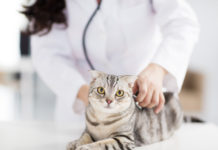Q. What is it you and your pals are doing when you tilt your head over to one side? It’s adorable. My cats will sometimes do it when looking at something they’re trying to figure out. Thanks for your fun column. Sincerely, Chip, Bianca and Molly’s mom
A. Thank you so much for recognizing how adorable it is when we cock our heads to one side. We’re only trying to look cute when we do this … it really serves no function. I’m kidding, although I’d have to think about this, which makes me want to tilt my head to the side, too!
Seriously, though, this behavior is to be distinguished from the dramatic tilting of the head that may suggest an inner ear infection (the inner ear is important for the maintenance of balance) or that may be seen when cats have ear mites or an external ear infection. Cats with abnormalities of the brain, including tumors, may also tilt their heads to one side, and any cat who demonstrates persistent head tilt and/or shaking of the head should be evaluated by a veterinarian promptly.
The behavior may be an attempt to gather more information about the world around them. In many cases, this head motion may be an attempt to more accurately localize the source of a sound (in direction and distance) that they are hearing. Sound results from the alternating compression (increase in density) and rarefaction (decrease in density) of the air (or whatever medium it travels through) in a wave-like fashion. This alternation results in vibrations of the air that displace the eardrums, and these displacements are translated into what is perceived as sound by the brain.
One way (among others) that animals use to determine the location of a sound source is called the interaural time difference (ITD). This is the difference in arrival time of a sound wave between the two ears. Since sound waves take time to travel through air, it makes sense that a sound that originates from the right of a cat’s head will arrive at the right ear before it arrives at the left ear. The cat can use this ITD to help localize the origin of a sound. One difficulty that cats (and other animals with symmetrically placed ears) may have in determining the source of a sound is that each ear is located at approximately the same height and distance from the nose as the other (i.e., the ears are symmetrically placed on the head).
In some cases, depending upon the location of the origin of a sound, the sound waves may arrive at both the right and left ears at the same time with the head in a normal position, making localization by ITD difficult. In such a case, the tilting of the head may alter the position of the ears relative to the origin of the sound (i.e., it may make one ear closer/farther to or higher/lower than the origin of the sound), thus facilitating the use of ITD to better localize its origin.
This head tilt, by altering the position of his ears relative to a sound source, may provide more accurate information about the location of the source. It is interesting to note that in owls, which have one of the most accurate abilities to locate the source of a sound in the animal kingdom, the ears are normally located in asymmetric positions, with one ear located farther forward on the head than the other. This facilitates the use of ITD to improve the accuracy of locating the sound source.
This head tilting behavior is similar, although not exactly analogous to, the up and down bobbing of the head seen in cats before jumping from one perch to another. It is believed that in this case, the kitty is trying to improve his visual depth perception of the target perch by obtaining several views from different perspectives to more accurately localize the landing spot.
I hope this gives you a better understanding of this endearing behavior. Please forward a picture of their head tilting shenanigans if you get the chance. It’s just so cute…even to us kitties!
—Sincerely, Elizabeth



